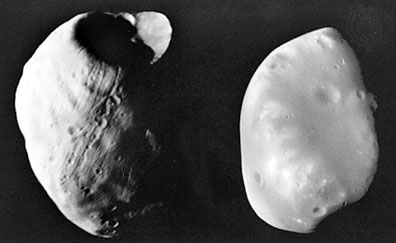
Viking orbiter photographs of (left) Phobos and (right) Deimos. The smooth texture of the surface of Deimos is contrasted with the grooved, pitted, and cratered surface of Phobos.

Viking orbiter photographs of (left) Phobos and (right) Deimos. The smooth texture of the surface of Deimos is contrasted with the grooved, pitted, and cratered surface of Phobos.
Deimos:
Deimos (Latin for Panic) is a moon of Mars and was named after an attendant of the Roman war god Mars. Deimos is a dark body that appears to be composed of C-type (blackish carbonaceous chondrite) surface materials. It is similar to the C-type asteroids that exist in the outer asteroid belt.
Deimos is the outer of the two satellites of Mars. Both these moons were discovered by the American astronomer Asaph Hall in 1877. A small, irregular, cratered body approximately 15x12x11 km (9x7x7 miles) across, Deimos circles the planet every 30.3 hours at a distance of 23,459 km (14,545 miles) in a circular orbit that lies within 2 degrees of Mars's equatorial plane. The satellite's longest axis is always directed toward Mars, making the spin period synchronous with the orbital one. The largest crater, located near the satellite's south pole, is about 2.5 km wide. Like that of its companion, Phobos, the surface of Deimos is gray and very dark (reflectance is only 7 percent, or about one-half that of the lunar surface). These facts and the satellite's low mean density (less than two grams per cubic centimetre) indicate a carbonaceous composition and suggest that Deimos may be a captured asteroid-like object. In spite of its tiny gravity (about 10-3 g), Deimos has retained considerable amounts of regolith on its surface.
Phobos :
Phobos (Latin for Fear) is the inner of the two moons. Phobos is an unusual moon in that it orbits so close to the Martian surface that its orbital period is less than Mar's rotation period. Thus, it appears to move West to East in the sky, rather than the East to West of all other objects.
Phobos is the inner of the two satellites of Mars. It was discovered by the American astronomer Asaph Hall in 1877. Phobos is a heavily cratered, small, irregular body that measures 26.6 km (16.5 miles) across at its widest point. It circles Mars every 7.65 hours at a distance of 9,378 km (5,814 miles) in a nearly circular orbit that lies only 1 from Mars's equatorial plane. Since the satellite's orbital period is less than the spin period of Mars (24 hours 37 minutes), Phobos moves from west to east in the Martian sky. The surface is covered with a gray, very dark regolith whose reflectance is only about 6 percent, or about one-half that of the lunar surface. These facts and the satellite's low mean density (2 grams per cubic centimetre) are consistent with a carbonaceous composition, suggesting that Phobos may be a captured asteroid-like object. Remarkable linear grooves, typically 100 m (328 feet) wide and 20 m (66 feet) deep, cover much of the surface. There is strong evidence that they are associated with the formation of the largest crater on Phobos; this structure, known as Stickney, measures about 10 km across. Precise observations of Phobos' position over the past century suggest that Mars's tides are slowly pulling the satellite toward the planet. If such is the case, Mars will have only one satellite--Deimos--in perhaps one billion years.
In 1988, two internationally built Mars probes sponsored by the Soviet Union were launched in an attempt to gain further information about Phobus. One probe was lost in 1988, and contact with the second was lost in March 1989, shortly before its destination was reached.
Excerpt from the Encyclopedia Britannica without permission.